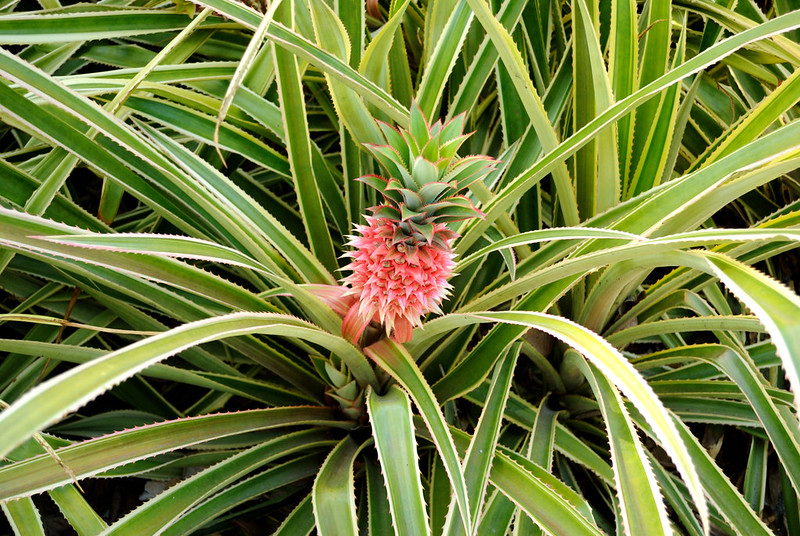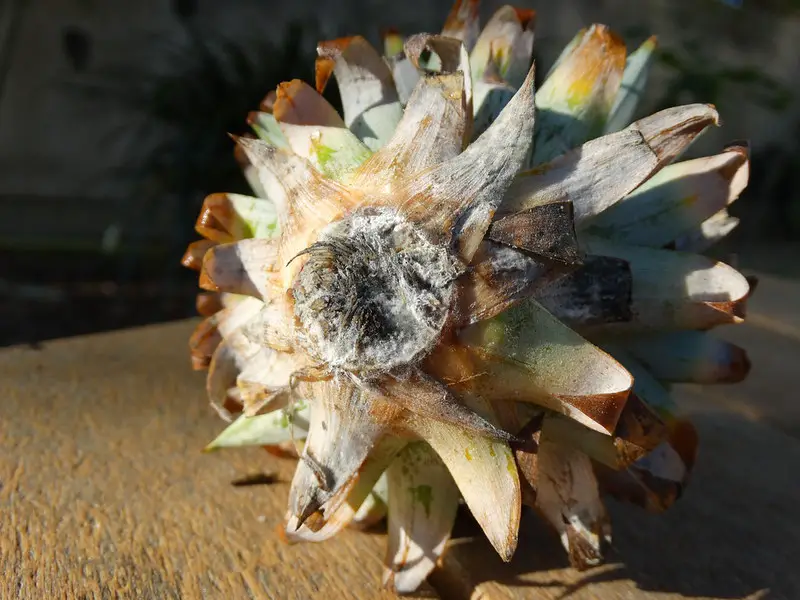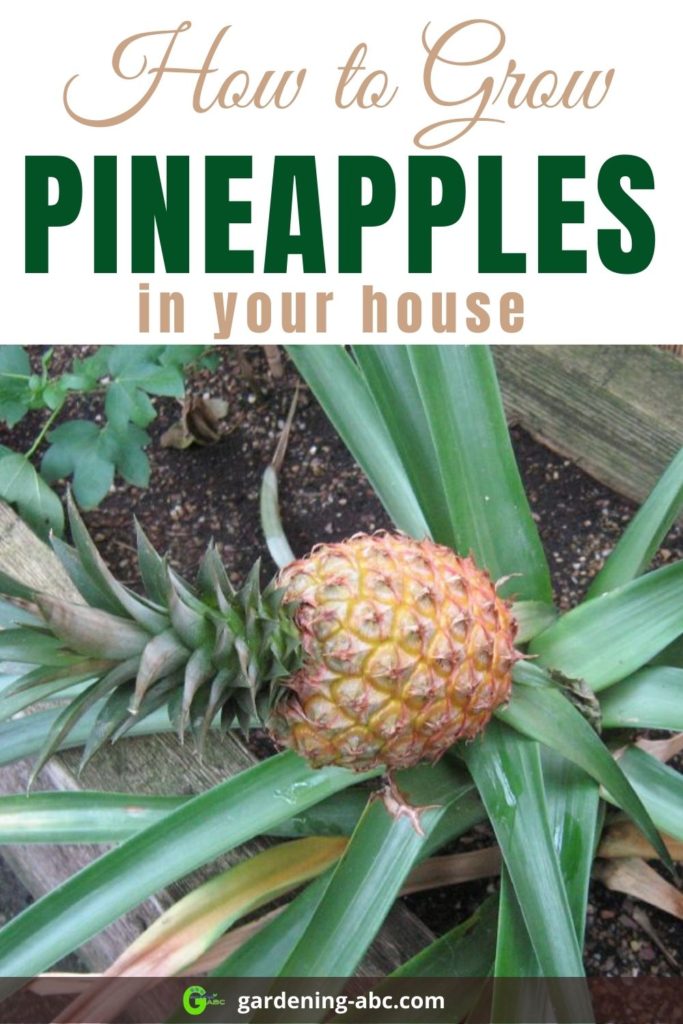We use affiliate links to run our site. When you buy through links on our site, we may earn an affiliate commission, without any added cost to you. Learn more
Homegrown Pineapples are always best in taste. They are nutritious and are quite easy to grow. In this article, we will discuss how to grow Pineapple plants in your garden.
Pineapple is a biennial or perennial, meaning the plant can live for two years or longer. While establishing and maintaining a Pineapple patch might seem like a lot of work, A Pineapple plant is actually easy to grow if you know the basics.
You can even grow pineapple plants as indoor plants and also get fruits (they will be smaller in size).
So without further ado let’s start discussing some growing tips for one of our favorite fruits: Pineapples.
How To Grow Pineapple Plants
Pineapple Varieties:
If you are growing Pineapple plants pay close attention to the types of Pineapples you choose. There are many varieties of pineapple available for growing.
You can either grow pineapple as a fruit or an ornamental plant. Ornamental pineapple plants are fantastic in outlook but they produce fruits that are not very flavorful. Always choose the variety that is best suited to your area.
Here are some of the most popular varieties of Pineapples:
1. Abacaxi Pineapples
One of the most popular pineapple varieties. They are very sweet and quite resistant to disease.
2. Queen Pineapples
Found mostly in Australia and South Africa. They are best to fresh.
3. Red Spanish Pineapples
They are orange-red in color and are grown mostly in the Caribbean.
4. Smooth Cayenne Pineapples
This is the most popular pineapple variety in the United States. They are bigger than most other varieties. They can weigh about four to ten pounds.
Planting Pineapples:
Climate:
Pineapple is a tropical plant. For growing pineapple plant a temperature range of 65°-95°F is best, The plant can tolerate cool nights for short periods but are sensitive to frost.
Ideal Soil and Fertilizers For Growing Pineapples:
The ideal soil for growing pineapple plants is sandy loam soil with good drainage. The soil should be high in organic matter. The ideal pH of the soil should be between 4.5 to 6.5.
If your soil is not sufficiently acidic add peat moss to achieve the desired level. The pineapple plant cannot tolerate waterlogging. So make sure your soil has good drainage. You can add coir or perlite to improve the drainage of the soil.
You can grow pineapples in 4-5-gallon planters. Bring the planters indoors during the colder winter months, near a sunny window.
Choose quality potting soil for growing pineapple plants and don’t forget to make a drainage hole in the container.
How To Plant Pineapples?
The planting process of a pineapple plant involves 3 main steps. These are:
- Preparing the pineapple for planting.
- Soaking the pineapple crown.
- Planting the crown.
1. Preparing The Pineapple for Planting:
Select a fresh pineapple fruit. The fruit should be golden brown in color and the leaves are still green. The fruit should be ripe but not too ripe.
Hold the body of the fruit with one hand and with the other grab the leaves and twist them off. Alternatively, you can slice the top of the fruit. Then remove the extra fruit portion around the roots.
New roots will be sprouting from the base, so make sure the base is intact. Expose the stem by lowering some leaves. The exposed stem will easily form roots.
Let the crown dry for a week. The scars will heal and the pineapple crown will be ready for planting.
2. Soaking The Pineapple Crown:
This portion is not compulsory and you can skip the steps if you want to. Put the base of the crown in water.
You can use toothpicks to suspend the crown base in water.
Keep the pot in a sunny window so that roots start to sprout. Change the water regularly so no mold is formed. The crown is ready for planting when the root becomes a few inches long.
3. Planting The Crown:
Now just make a small hole in the ground. Plant the pineapple crown in the soil keeping the base of any remaining leaves just above soil level.
Cover the base of the crown with soil. Make it firm around the base so the crown sits straight and doesn’t fall over. While putting the soil, make sure the leaves are not covered by it.
Watering A pineapple Plant:
Pineapple needs very little water. As the leaves are tough they don’t lose much water through evaporation. If water is scarce in your area it is good news for you.
Whenever you water your pineapple plant make sure that the excess water drains away quickly.
Mulching Your Pineapple Plants:
Your Pineapple plants need mulching for protection from the cold. Apply approximately 4 inches of mulch in December or before the frosting date.
You can remove the mulch cover in springs once the dangers of frosting are over. Once you see the fruits begin to form apply a layer of straw mulch.
These have dual benefits. They help to retain the moisture in the soil and also save the fruit from getting the dirt once it is matured.
Related read: The basics of mulching
Pineapple Flowers:

Pineapple plants need 2-3 years of maturing before they start flowering and fruiting.
The flower blooms for approximately two weeks and then begin setting its fruit. Each plant only flowers and fruits once in its lifetime.
Pruning Your Pineapple Plants:
A well-timed pruning is just what a pineapple plant needs. It will look pretty and will yield a better, more fruitful crop.
To prevent sprawling, you may have to trim the large leaves of the pineapple plant from time to time. You can also prune the ground suckers. They produce the smallest fruits so they are best to be discarded.
Lift the healthy leaves with one hand and reach down toward the base of the pineapple plant. Using a sharp knife, cut the dead leaf from the plant where it meets the stalk. Be very careful so that you don’t damage the roots or the stalk of the plant.
Pruning pineapples is all about appearance rather than encouraging plant health.
Harvesting Pineapples:
When the pineapple matures, the fruitlets start to flatten. The peel also starts to change color to yellow. The change of color starts at the bottom of the fruit and then moves to the top.
Check the smell before harvesting your pineapples. A distinct sweet and tangy smell indicates the fruit is ripening. You can tap the fruit. If it sounds solid the time is right to harvest the pineapple. On the other hand, if it sounds hollow, leave the fruit on the plant to ripen further.
While harvesting, use a sharp knife to cut where the pineapple joins the stalk. Don’t pull the fruits it can damage the plant. After harvesting store the pineapples in the refrigerator or outside for more ripening.
Bird Control In Pineapple Gardening:
Birds can be a threat to your Pineapple production. One of the possible solutions is to use bird nets.
Anchor the net all the way around the planting and cover the plants carefully. If you are failed to anchor the net birds will walk under it.
Related read: What are the best fencing materials for protecting your garden
Common Pests and Diseases of A Pineapple Plant:
Diseases of Pineapples:
The followings are some of the most common diseases of a pineapple plant:
Bacterial Heart Rot and Fruit Collapse:
If your pineapple plant is affected by this disease you will see water-soaked lesions on the leaves. Midportions of leaves become bloated. The infected fruits will exude juices. You will also find cavities within the fruit.
Remove and destroy infected fruits. Don’t use the crowns of these infected fruits to grow a pineapple.
Top Rot and Root Rot:
Caused by the soil fungi Phytophthora cinnamomi and P. nicotianae var. Parasitica.
Improve drainage of the soil. This will reduce the risk. You can also use plastic mulch to reduce the impact.
Butt rot, Black rot & White leaf spot:

This fungal disease creates soft black rot on the entire seed piece. It causes a soft, watery rot which becomes dark later. Small brown, wet spots develop on leaves.
Crookneck:
The disease is caused by the deficiency of zinc. The heart leaves become curled and twisted, and light yellowish-green. The plant can also bend over and grows in an almost horizontal position.
Add compost or other organic matter to help the soil manage zinc better. Cut back on high phosphorus fertilizers because they reduce the amount of zinc available to the plants.
Sunburn or Sunscald:
Cut the fruit as soon as you notice the disease and safely dispose of it so other fruits don’t get contaminated. Use straw, paper sleeves, or dry grass to protect the fruits that mature in the summer.
Pests of Pineapple Plants:
Some of the most common pests of a pineapple plant are:
Nematodes:
They can cause the degeneration of pineapple plants. You can use these methods to prevent nematodes in the garden.
Mealybugs:
The bugs attack leaves and cause them to wilt. The leaves can turn orange or brown. To control Mealybugs use beneficial insects such as ladybeetles.
Cutworms:
They eat holes in the base of the immature fruit. Use organic pest control techniques to prevent such attacks.
The unfortunate part of Pineapple is that it is quite prone to diseases. So start smart. Buy only certified plants from your nearby nurseries.
Nutritional Value of A Pineapple:
Other than the delicious taste, eating Pineapples are also a good source of nutrients. Pineapples are rich in vitamin C and manganese and are rich in dietary fibers.
So enjoy the fruit and also get those needed vitamins and minerals into your system.
Tricks and Tips for Growing Pineapples:
- Pineapples grow pretty large so if you are growing in a pot consider a big-sized pot.
- Water when the soil is dry several inches below the soil line.
- Pineapples don’t need a lot of fertilizer. One application a year during the summer months is sufficient.
- Bring the plant indoors before temperatures drop below 40 degrees.
- While they are tropical plants, pineapples require only a few hours of direct sunlight a day. During summer arrange some kind of protection from the hot afternoon sun.
I hope you got some useful ideas on how you can grow pineapples in your house.
Don’t forget to pin it.

Amazon and the Amazon logo are trademarks of Amazon.com, Inc, or its affiliates.

Hi there! My name is Prasenjit and I’m an avid gardener and someone who has grown a passion for growing plants. From my hands-on experience, I have learned what works and what doesn’t. Here I share everything I have learned.
